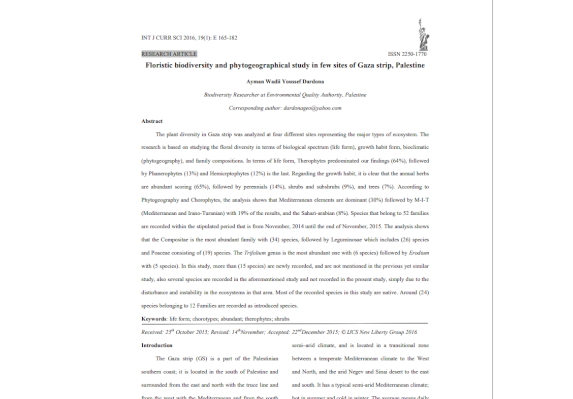Floristic biodiversity and phytogeographical study in few sites of Gaza strip, Palestine
Floristic biodiversity and phytogeographical study in few sites of Gaza strip, Palestine
Ayman Wadii Youssef Dardona
Biodiversity Researcher at Environmental Quality Authority, Palestine
Corresponding author: [email protected]
Abstract
The plant diversity in Gaza strip was analyzed at four different sites representing the major types of ecosystem. The research is based on studying the floral diversity in terms of biological spectrum (life form), growth habit form, bioclimatic (phytogeography), and family compositions. In terms of life form, Therophytes predominated our findings (64%), followed by Phanerophytes (13%) and Hemicrptophytes (12%) is the last. Regarding the growth habit, it is clear that the annual herbs are abundant scoring (65%), followed by perennials (14%), shrubs and subshrubs (9%), and trees (7%). According to Phytogeography and Chorophytes, the analysis shows that Mediterranean elements are dominant (30%) followed by M-I-T (Mediterranean and Irano-Turanian) with 19% of the results, and the Sahari-arabian (8%). Species that belong to 52 families are recorded within the stipulated period that is from November, 2014 until the end of November, 2015. The analysis shows that the Compositae is the most abundant family with (34) species, followed by Leguminosae which includes (26) species and Poaceae consisting of (19) species. The Trifolium genus is the most abundant one with (6 species) followed by Erodium with (5 species). In this study, more than (15 species) are newly recorded, and are not mentioned in the previous yet similar study, also several species are recorded in the aforementioned study and not recorded in the present study, simply due to the disturbance and instability in the ecosystems in that area. Most of the recorded species in this study are native. Around (24) species belonging to 12 Families are recorded as introduced species.
Keywords: life form; chorotypes; abundant; therophytes; shrubs

